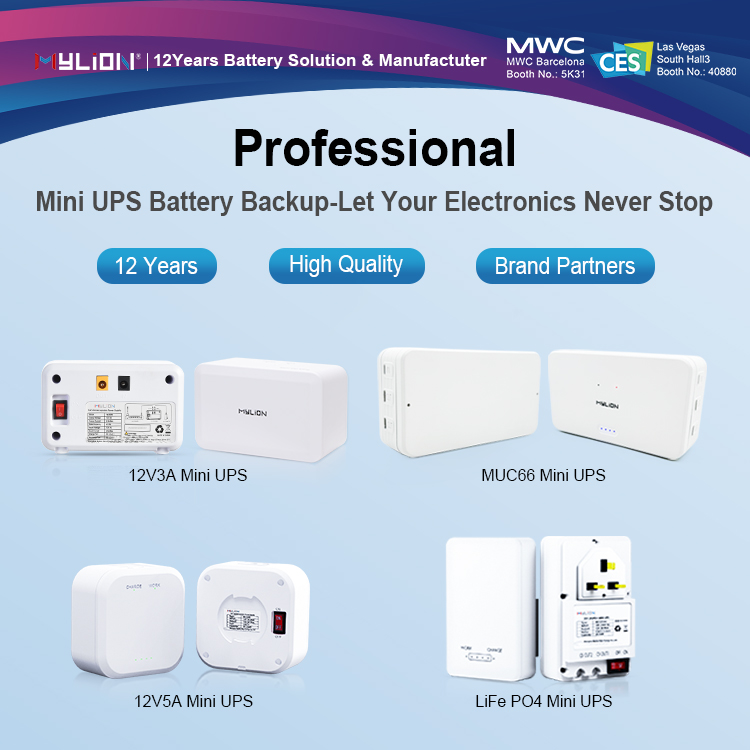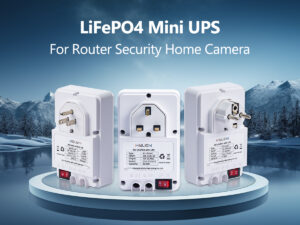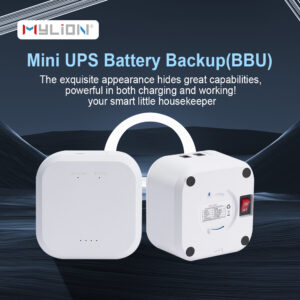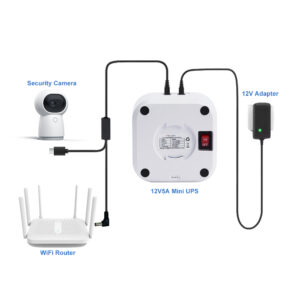As modern homes and businesses become increasingly reliant on electronic devices, Mini UPS has become an important solution for providing backup power and protecting critical equipment from power outages. In addition to ensuring uninterrupted operation, Mini UPS offers significant advantages in safety and environmental sustainability. Through efficient battery management, energy-saving design, and environmentally friendly materials, Mini UPS helps build greener and more reliable power solutions. This article explores how Mini UPS can improve safety while minimizing environmental impact.

Safety Features of Mini UPS
- Advanced Battery Management System (BMS)
One of the key safety features of Mini UPS is its Battery Management System (BMS), which optimizes battery performance while preventing potential hazards. BMS plays a key role in the following aspects:
Overcharge protection: prevents excessive voltage input, reducing the risk of battery expansion or thermal runaway.
Over-discharge protection: ensures that the battery does not drop below a critical level, thereby maintaining the health and life of the battery.
Short circuit protection: detects and prevents electrical short circuits, which may cause overheating or fire hazards.
Temperature regulation: monitors battery temperature to prevent overheating or ice formation, ensuring safe operation.
By integrating these protections, Mini UPS ensures safe and stable power delivery, making it ideal for home networks, security systems and sensitive electronics.
- Fire and overheating protection
High-quality Mini UPS units use fire-resistant casings and thermal management systems to prevent overheating. Many models also have automatic shutdown mechanisms that deactivate the device in extreme temperatures, reducing the risk of electrical fires.
- Stable voltage output
Power fluctuations and surges can damage sensitive electronic devices. Mini UPS stabilizes voltage output to prevent damage to devices such as routers, smart home systems, and medical equipment. By ensuring a steady supply of power, a mini UPS protects devices from sudden electrical spikes or failures.
- Low Electromagnetic Interference (EMI)
Some small UPS systems are designed with low EMI to ensure they do not interfere with nearby electronic devices. This is especially important in medical environments, where interference could disrupt critical monitoring systems.

Environmental Benefits of Mini UPS
- Energy-saving Design
Modern Mini UPS units feature highly efficient power conversion systems that minimize energy loss during charging and discharging cycles. Compared to older backup power solutions, they reduce standby power consumption, helping to lower energy bills and reduce carbon footprint.
Many Mini UPS models feature an intelligent energy-saving mode that automatically adjusts power output based on demand. This feature optimizes energy use and extends battery life, reducing the need for frequent replacement.
- Adopting environmentally friendly battery technology
Unlike traditional lead-acid batteries that contain toxic heavy metals, many Mini UPS devices now feature LiFePO4 (lithium iron phosphate) batteries, which offer:
Longer service life (up to 5,000 charging cycles)
Lower risk of thermal runaway (higher thermal stability)
Non-toxic and recyclable materials
By using LiFePO4 and other advanced battery chemistries, Mini UPS reduces hazardous waste and improves sustainability.
- Reduce E-waste
Compared to traditional backup power solutions, Mini UPS has a longer service life, reducing electronic waste. Many traditional UPS systems require battery replacement every 2-3 years, while high-quality mini UPS units can last 5-10 years, significantly reducing discarded batteries.
In addition, mini UPS are often designed with modular and replaceable battery systems, allowing users to replace old batteries rather than discarding the entire unit. This approach meets global sustainability goals and reduces landfill contamination.
- Environmentally friendly materials and manufacturing
Many mini UPS manufacturers use recyclable and RoHS-compliant materials, reducing the use of hazardous substances such as lead, mercury and cadmium. In addition, production facilities are implementing low-carbon manufacturing processes to further minimize environmental impact.
Practical Applications of Green Mini UPS Solutions
- Home Networking and Smart Home
Mini UPS keeps home routers, modems, and smart home hubs running during power outages, preventing data loss and connection loss. By using energy-saving standby mode, unnecessary power consumption can be minimized when the grid is stable.
- Security and Surveillance Systems
Security cameras and alarm systems require uninterruptible power to operate effectively. Mini UPS can ensure that these critical devices continue to operate even during power outages, enhancing the security of homes and businesses.
- Healthcare Equipment
Home healthcare equipment, such as CPAP machines, blood glucose monitors, and telemedicine systems, rely on Mini UPS to provide stable power and prevent failure during power outages. LiFePO4-based Mini UPS does not contain toxic chemicals, ensuring they meet health and safety standards.
- Renewable Energy Grid Connection
Solar homes and off-grid cabins use Mini UPS to store excess energy and provide power during cloudy or nighttime conditions. The combination of Mini UPS with solar and wind power enhances energy independence while reducing dependence on fossil fuels.

How to Choose an Eco-Friendly and Safe Mini UPS
To ensure maximum safety and environmental benefits, consider the following when choosing a mini UPS:
Battery Type – Prefer LiFePO4 or Li-ion batteries over lead-acid batteries for higher efficiency and longer life.
Energy Efficiency – Look for low standby power consumption and smart charging technology.
Safety Features – Ensure BMS protection, thermal sensors, and short-circuit prevention.
Eco-Certification – Choose products with RoHS, CE, and UL environmental compliance certifications.
Replaceable Battery Modules – Choose models that allow for battery replacement rather than entire unit replacement.
Conclusion
The development of mini UPS technology has not only improved the reliability of backup power, but also helped create a safer and greener energy landscape. With advanced battery management, energy-efficient design, and environmentally friendly materials, modern mini UPS systems provide sustainable power solutions for homes, businesses, and off-grid applications.
By choosing a mini UPS that prioritizes safety and environmental responsibility, users can enjoy uninterrupted power while reducing their carbon footprint. As the demand for green energy solutions continues to grow, Mini UPS will continue to play a key role in building a more sustainable and energy-efficient future.




